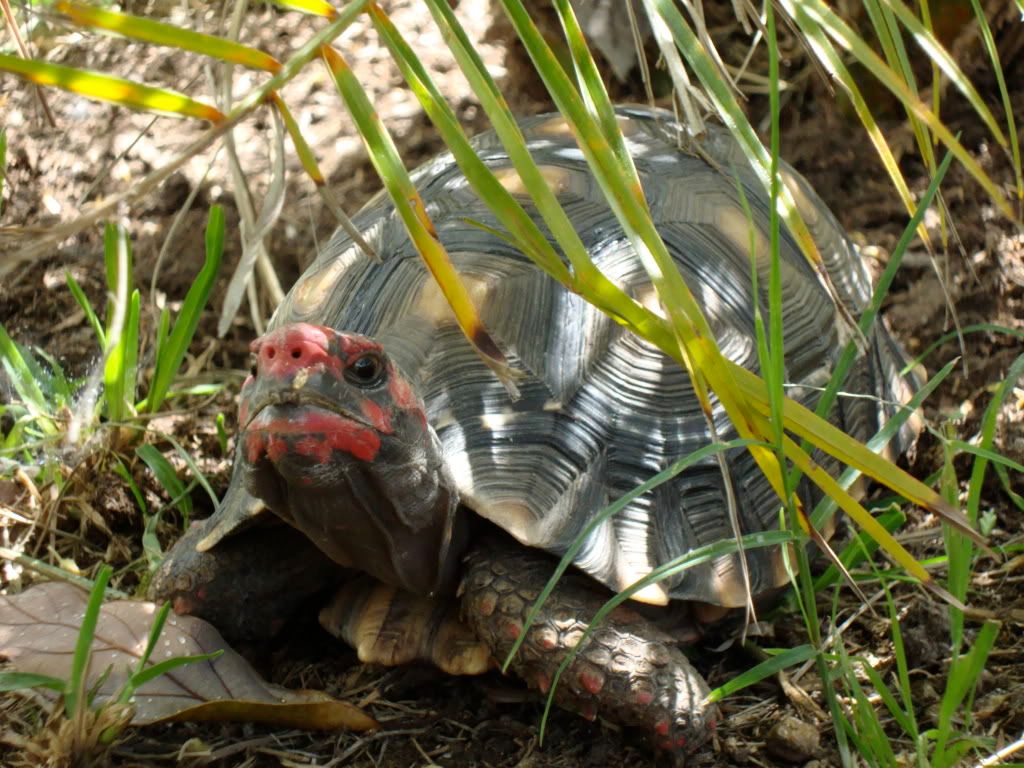Welcome to the second season of Tortoise Mythbusters, where we take comments made about tortoises and see if we can prove or disprove them on the basis of good scientific principles!
Today's topic: "Red-foots are forest tortoises".
This is a commonly seen statement and seems to drive a lot of care recommendations- 'Red-foots are sensitive to light', 'Red-foots need fruit or meat', etc. because they are considered a rain forest animal.
BUSTED. While Red-foots are found in the deep forest in some places, their distribution is more weighted to habitats AROUND the rain forests and rain forest openings. If you look at a map of their range and South American land uses, most of their range is to the north and to the south of the Amazon Basin rain forest zone.
Most researchers and authors say the same thing. Part of the problem is that most writers use the word 'tropical' to describe the wild habitats and it is easy to see that and assume 'rain forest', but tropical simply means that it lives in the 'tropical zone' of the world between the Tropic of Cancer and the Tropic of Capricorn.
Part of the problem is that we don't know as much about this species as we would like to. We don't know the exact range, possible subspecies, hatchling behavior, etc. Part of the problem is our casual use of the word 'forest', again, which implies rain forest while much of the habitat is scrub forest, thorn forest, and other types of habitat.
Still not convinced? In South America, the common name for the Red-foot is 'Savannah Tortoise'. The Yellow-foot is the 'Forest Tortoise'. In other words, the people who live with them recognize this basic difference.
There are some implications for cares with this. Red-foots do experience seasons- although they are not as extreme as ours. They also get a lot of light, including UVB, from the wild. They are not particularly light sensitive- although hatchlings of all tort species are shy, and it is easy to over-light any tortoises cage.
Bottom line- Red-foots are not ANTI-forest species, but an adaptable species that is at home in a wide variety of habitat... just mostly the 'wet savannahs' for most if its range.
Today's topic: "Red-foots are forest tortoises".
This is a commonly seen statement and seems to drive a lot of care recommendations- 'Red-foots are sensitive to light', 'Red-foots need fruit or meat', etc. because they are considered a rain forest animal.
BUSTED. While Red-foots are found in the deep forest in some places, their distribution is more weighted to habitats AROUND the rain forests and rain forest openings. If you look at a map of their range and South American land uses, most of their range is to the north and to the south of the Amazon Basin rain forest zone.
Most researchers and authors say the same thing. Part of the problem is that most writers use the word 'tropical' to describe the wild habitats and it is easy to see that and assume 'rain forest', but tropical simply means that it lives in the 'tropical zone' of the world between the Tropic of Cancer and the Tropic of Capricorn.
Part of the problem is that we don't know as much about this species as we would like to. We don't know the exact range, possible subspecies, hatchling behavior, etc. Part of the problem is our casual use of the word 'forest', again, which implies rain forest while much of the habitat is scrub forest, thorn forest, and other types of habitat.
Still not convinced? In South America, the common name for the Red-foot is 'Savannah Tortoise'. The Yellow-foot is the 'Forest Tortoise'. In other words, the people who live with them recognize this basic difference.
There are some implications for cares with this. Red-foots do experience seasons- although they are not as extreme as ours. They also get a lot of light, including UVB, from the wild. They are not particularly light sensitive- although hatchlings of all tort species are shy, and it is easy to over-light any tortoises cage.
Bottom line- Red-foots are not ANTI-forest species, but an adaptable species that is at home in a wide variety of habitat... just mostly the 'wet savannahs' for most if its range.

